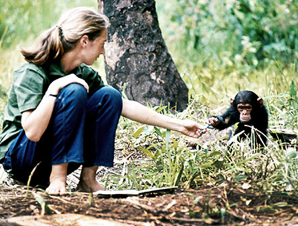|
|
Our brain, more than chimp's, influenced by epigenetics
Human brains exhibit more of a tendency to be modeled by epigenetic influences than chimpanzee brains. This may account for part of our evolutionary differences.
The findings are from research at Georgia State University, the George Washington University and The University of Texas MD Anderson Cancer Center. They provide insight into why humans are capable of adapting to various environments and cultures much more readily than our chimp cousins.
In genetics, epigenetics is the study of cellular and physiological variations caused by environmental factors. These factors can switch genes on and off and affect how cells read genes already in place. We tend to think our DNA sequence is the root cause of any change in how our body functions. But DNA is more a blueprint of our physical structure, while deletions and corrections are subject to environmental influences - socially and culturally, as well.
This study is the first of its kind to examine inherited genetic factors of brain organization in humans as compared to our closest living genetic relatives, the chimpanzees. It was published Nov. 16 in the journal Proceedings of the National Academy of Sciences, or PNAS.
Research teams studied 218 human brains and 206 chimpanzee brains to compare two things: brain size and organization as related to gene similarity.
First they found that human and chimpanzee brain sizes were both greatly influenced by genetics.
However, brain organization revealed key differences. In chimpanzees, brain organization is highly inherited, but in humans, not so much.
"We found that the anatomy of the chimpanzee brain is more strongly controlled by genes than that of human brains, suggesting the human brain is extensively shaped by its environment no matter its genetics."
Aida Gómez-Robles PhD, postdoctoral scientist, The Center for the Advanced Study of Human Paleobiology, The George Washington University, Washington, DC, USA, and lead author on the paper.
MRI scans were used to measure brain volume and reconstruct 3D models of the cortical surface of each brain.
Chimpanzees used in the study were housed at the Yerkes National Primate Research Center in Atlanta and at the University of Texas MD Anderson Cancer Center in Bastrop, Texas.
Human brains examined for the study were from twins (identical and fraternal) or siblings, while the chimpanzee brains had a variety of kinship relationships, including mothers and offspring or half siblings.
This relaxed genetic control on cortical organization is especially obvious in areas proximate to each other and is likely related to microstructural changes in neural circuits.
A major result of increased brain plasticity is development of these neural circuits as they underlie our behavior. These circuits are shaped by environment, society, and culture more intensively in humans than in other primates, and most likely provide the anatomical basis for our behavioral and cognitive evolution.
The findings could also have important implications regarding human susceptibility to degenerative diseases.
"Though our findings suggest that the increased plasticity found in human brains has many benefits for adaptation, it is also possible that it makes our brain more vulnerable to many human-specific neurodegenerative and neurodevelopment disorders."
William Hopkins PhD, professor in the Neuroscience Institute at Georgia State University, Atlanta, Georgia, USA.
Significance
Despite decades of research, we still have a very incomplete understanding of what is special about the human brain compared with the brains of our closest fossil and living relatives. Parsing the genetic versus environmental factors that govern the structure of the cerebral cortex in humans and chimpanzees may shed light on the evolution of behavioral flexibility in the human lineage. We show that the morphology of the human cerebral cortex is substantially less genetically heritable than in chimpanzees and therefore is more responsive to molding by environmental influences. This anatomical property of increased plasticity, which is likely related to the human pattern of development, may underlie our species’ capacity for cultural evolution.
Abstract
The study of hominin brain evolution has focused largely on the neocortical expansion and reorganization undergone by humans as inferred from the endocranial fossil record. Comparisons of modern human brains with those of chimpanzees provide an additional line of evidence to define key neural traits that have emerged in human evolution and that underlie our unique behavioral specializations. In an attempt to identify fundamental developmental differences, we have estimated the genetic bases of brain size and cortical organization in chimpanzees and humans by studying phenotypic similarities between individuals with known kinship relationships. We show that, although heritability for brain size and cortical organization is high in chimpanzees, cerebral cortical anatomy is substantially less genetically heritable than brain size in humans, indicating greater plasticity and increased environmental influence on neurodevelopment in our species. This relaxed genetic control on cortical organization is especially marked in association areas and likely is related to underlying microstructural changes in neural circuitry. A major result of increased plasticity is that the development of neural circuits that underlie behavior is shaped by the environmental, social, and cultural context more intensively in humans than in other primate species, thus providing an anatomical basis for behavioral and cognitive evolution.
Collaborators for the project include Chet C. Sherwood of the George Washington University and Steven J. Schapiro of The University of Texas MD Anderson Cancer Center.
This article contains supporting information online at www.pnas.org/lookup/suppl/doi:10.1073/pnas.1512646112/-/DCSupplemental.
The study was funded by the National Institutes of Health and James S. McDonnell Foundation.
Return to top of page
|
|
|
Nov 18, 2015 Fetal Timeline Maternal Timeline News News Archive

Human and chimpanzee brain sizes are both greatly influenced by genetics.
However, chimpanzees' brain organization is highly inherited. But the human
brain appears more extensively shaped by its' environment, society, and culture.
Image Credit: The Jane Goodall Institute
|
|
| |
|



